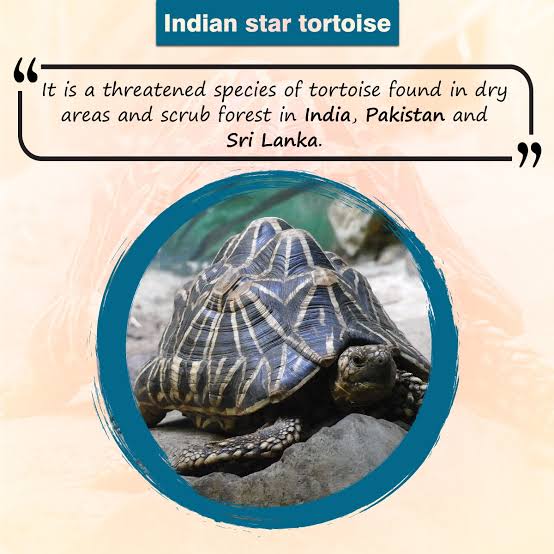
The Indian Star turtle (Geochelone elegans) is a threatened species of turtle that lives in dry areas and scrub forests in India, Pakistan, and Sri Lanka. It is kept as a pet in South East Asia, Europe, and North America. Indian Star Tortoises are brought into Japan and China because it is thought that having one as a pet will bring good luck and that it can be used as medicine.
• Habitat: The Indian star tortoise lives all over the Indian subcontinent, especially in the central and southern parts of India, in West Pakistan, and in Sri Lanka.
They live in the Indian states of Odisha, Kerala, Tamil Nadu, Karnataka, Gujarat, Punjab, and Gujarat.
Schedule IV of the Wild Life Protection Act of 1972 says that this list is for species that are not in danger of going extinct. It has species that are protected, but the punishment for breaking the law is less than in Schedules I and II.
Appendix I of the Convention on International Trade in Endangered Species (CITES) IUCN Status: Vulnerable
• Threat: Loss of habitat due to farming and illegal gathering for the pet trade are two things that could hurt this species.
Because Indian star tortoises are in such high demand, they have been smuggled from India to South-East Asian countries for a long time, even though India’s Customs Authorities and international laws have tried to stop this for a long time.
The Wildlife Crime Control Bureau says that the international pet market is where 90% of Star Tortoises are traded.
If they had been used at the same rate or even more, their numbers would have dropped by more than 30% by 2025.
• Conservation Efforts: The Convention on International Trade in Endangered Species of Wild Fauna and Flora (CITES) recently agreed to India’s plan to move the Star Tortoise from Appendix II to Appendix I on the list of endangered species.
The Indian star tortoise has a medium-sized head, a hooked beak, and short, thick legs with tubercles of different sizes and shapes all over them. The males have long tails, but the females’ tails are short and stumpy.
The Indian star tortoise is a diurnal animal, which means it is most busy in the morning and late afternoon.
Behaviour and personality: Indian star tortoises don’t like to be touched. If you touch them a lot, they can get stressed out and sick.
How they eat: Star tortoises eat plants. They need a lot of fresh grasses and veggies with dark leaves.









![UPSC CSE Topper Mains Answer [Part 1] images-2023-06-17T191749.185](https://iasbio.com/wp-content/uploads/2023/06/images-2023-06-17T191749.185-150x150.jpeg)






